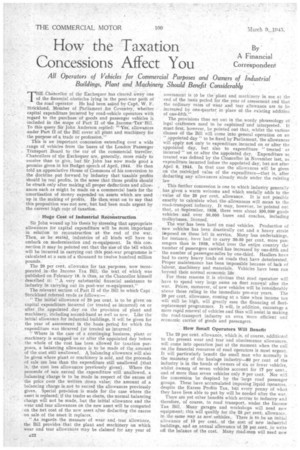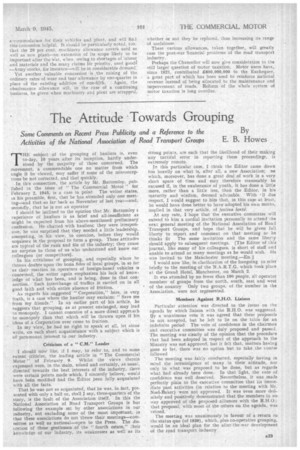How the Taxation Concessions Affect You
Page 24

Page 25

If you've noticed an error in this article please click here to report it so we can fix it.
All Operators of Vehicles for Commercial Purposes and Owners of Industrial Buildings, Plant and Machinery Should Benefit Considerably
By.
A Financial Correspondent
THE Chancellor of the Exchequer has cleared away one of the financial obstacles lying in the post-war path of the road operator He had been asked by Capt. W. F. Strickland, Member of Parliament for Coventry, whether capital expenditure incurred by road-vehicle operators with regard to the purchase of goods and passenger vehicles is included in the scope of Part II of the Income Tax Bill. To this query Sir John Anderson replied: " Yes, allowances under Part II of the Bill cover all plant and machinery for the purpose of a trade or profession."
This is an important concession extending over a wide range of vehicles from the buses of the London Passenger Transport .Board to the car of the commercial traveller. Chancellors of the Exchequer are, generally, more ready to ieceive than to give, but Sir John has now made good a promise given in his Budget speech of April, 1944. He then told an appreciative House of Commons of his conversion to the doctrine put forward by industry that taxable profits should be real profits, in the sense that those profits should be struck only after making all proper deductions and allowances such as might be made on a commercial basis for the amortisation of money expended on assets which are used up in the making of profits. He then went on to say that this proposition was not new, but had been made urgent by the current high ra$e of taxation. . .
Huge Cost of Industrial Reconstruction Sir John wound up his thesis by stressing that appropriate allowances for capital expenditure will be most important in relation to reconstruction at the end of the war. Then, as he stated, industries of all kinds will have to embark on modernization and re-equipment. In this connection it may be pointed out that the size of the bill which will be incurred in carrying out this post-war programme is calculated at a sum of a thousand to twelve hundred million pounds. . The 20 per cent. allowance for tax purposes, now incorporated in the Income Tax Bill, the text, of which was published on February 16, is thus, as the Chancellor himself described it: " A very substantial financial assistance to industry in carrying out its post-war re-equipment." The relevant section of Part II of the Bill to which Capt . Strickland referred reads as follows:— " The initial allowance of 20 per cent. is to be given on capital expenditure incurred (or treated as incurred) on or after the appointed day on the provision of plant and machinery, including second-hand as well as new. Like the initial allowance for industrial buildings, it will be given for the year of assessment in the basis period for which the expenditure was incurred (or treated as incurred) '.' Where in the case of a continuing business, plant or • machinery is scrapped on or after the appointed day before the whole of the cost has been allowed for taxation purposes, a balancing allowance is to be made of the amount of the cost still unallowed. A, balancing allowance will also be given where plant or machinery is sold, and the proceeds of sale are less than the expenditure still unallowed that is, the cost less allowances previously given) Where the proceeds of sale exceed the expenditure still unallowed, a balancing charge is to be made in respect of the excess of the price over the written clown value; the amount of a balancing charge is notto exceed the allowances previously given. Special provision is made for the case where the asset is replaced; if the trader so elects, the normal balancing charge will not be made, but the initial allowance and the wear and tear allowances on the new asset will be computed on the net cost of the new asset after deducting the excess on sale. of the asset it replaces, " As regardsthe measure of wear and tear allowance, the 13111 provides -that the plant and machinery on which wear and tear allowances may be claimed for any year of
assessment is tO be the-plant and machinery in use at the end of the basis period for the year of assessment and that the ordinary rates of wear and tear allowance are to be increased by one-quarter in place of the existing addition of one-fifth."
The provisions thus set out in the wordy phraseology of legal craftsmen need to be explained and interpreted. It must first, however, be pointed out that, whilst the various clauses of the Bill will come into general operation on an " appointed day" to be fixed by Parliament, the allowances will apply not only to expenditure incurred on or after the appointed day, but also to expenditure" treated as incurred " on or after the appointed day. Expenditure so treated was defined by the Chancellor in November last, as expenditure incurred before the appointed day, but not after April 6, 1944. In that case the allowances will be given on the restricted value of the expenditure—that is, after deducting any allowances already made under the existing law
This further concession is one to which industry generally has given a warm welcome and which usefully adds to the value of the 20 per cent. allowance. It is not possible exactly to calculate what theallowances will mean to the road-transport industry. It may, however, be pointed out that, at September, 1938, there were about 590,000goods vehicles and over 50,000 buses and coaches, including trolleybuses, licensed.
The war has been hard on road vehicles. Production of new vehicles has been drastically cut and a heavy strain itinposed on those left in service. Many bus undertakings, for instance, have had to carry 30-50 per cent, more passengers than in 1938, whilst over the entire country the number of passengers carried has increased by one-fifth and . the number of passenger-miles by one-third. Hauliers have had to carry heavy loads on roads that have deteriorated. Proper maintenance has been impossible because of lack of labour, machinery and materials. Vehicles have been run beyond their normal economic life For these reasons it is obvious that road operators will have to spend very large sums on fleet renewal after the war. Prices, moreover, of new vehicles will be considerably above those ruling in the immediate pre-war years. The 20 per cent, allowance, coming at a time when income tax will still be high, will greatly ease the &lancing of fleetreplacement programmes. It will, in addition, encourage a more rapid renewal of vehicles and thus will assist in making the road-transport industry an even more efficient and economic carrier of goods and passengers.
How Small Operators Will Benefit The 20 per cent. allowance, which is, of course, additional to the present wear and tear and obsolescence allowances, will come into operation just at the moment when the call on ,the financial resources of road operators is most urgent. It will particularly benefit the small man who normally is the mainstay of the haulage industry-80 per cent of the industry is in the hands of owners of six or fewer vehicles, whilst owner § of seven vehicles account for 17 per cent., and of more than seven vehicles only 3per cent. Nor will the concession be despised by the 'large road passenger groups. These have accumulated imposing liquid resources, despite the Excess Profits Tax, but every penny of what they have been able to put by will be needed after the war, There are yet other benefits which accrue to industry and therefore, of course, to road transport, under. the Income Tax Bill, . Many garages and workshops will need new -equipment; this will qualify for the 20 per cent, allowance, in the same way as new. vehicles. There is to be an initial allowance of 10 per cent. of the cost of new industrial buildings, and an annual allowance of 20 per, cent, ,to write off the balance of the cost. Many rbad-men will need new
accommodation for their vehicles and plant, and will find this concession helpful. It should be particularly noted, too. that the 20 per cent. machinery allowance cover'sused as well as new plant—an extension of its scope likely to he important after the war, when, owing to shortages of labour and materials and the many claims fcir priority, used good4 —Army stotks, for instance—will be in considerable demand.
Yet another valuable concession is ,the raising of the ordinary rates of •wear and tear allowance by one-quarter in
place of the existing addition of one-fifth. Again, the obsolescence allowance will, in the case of a continuing. business, he given when machinery and plant are scrapped,
whether or not they be replaced, thus increasing its range of usefulness.
These various allowances, taken together, will greatly ease the post-war linancial problems of the road transport industry.
Perhaps the Chancellor will now give consideration to the still larger question of motor taxation. Motor users have, since 1921, contributed 2800,000,000 to the Exchequer, a great part of which has been used to reinforce national revenue instead of being allocated to the maintenance and improvement of roads. Reform of the whole system of motor taxation is long overdue.





















































